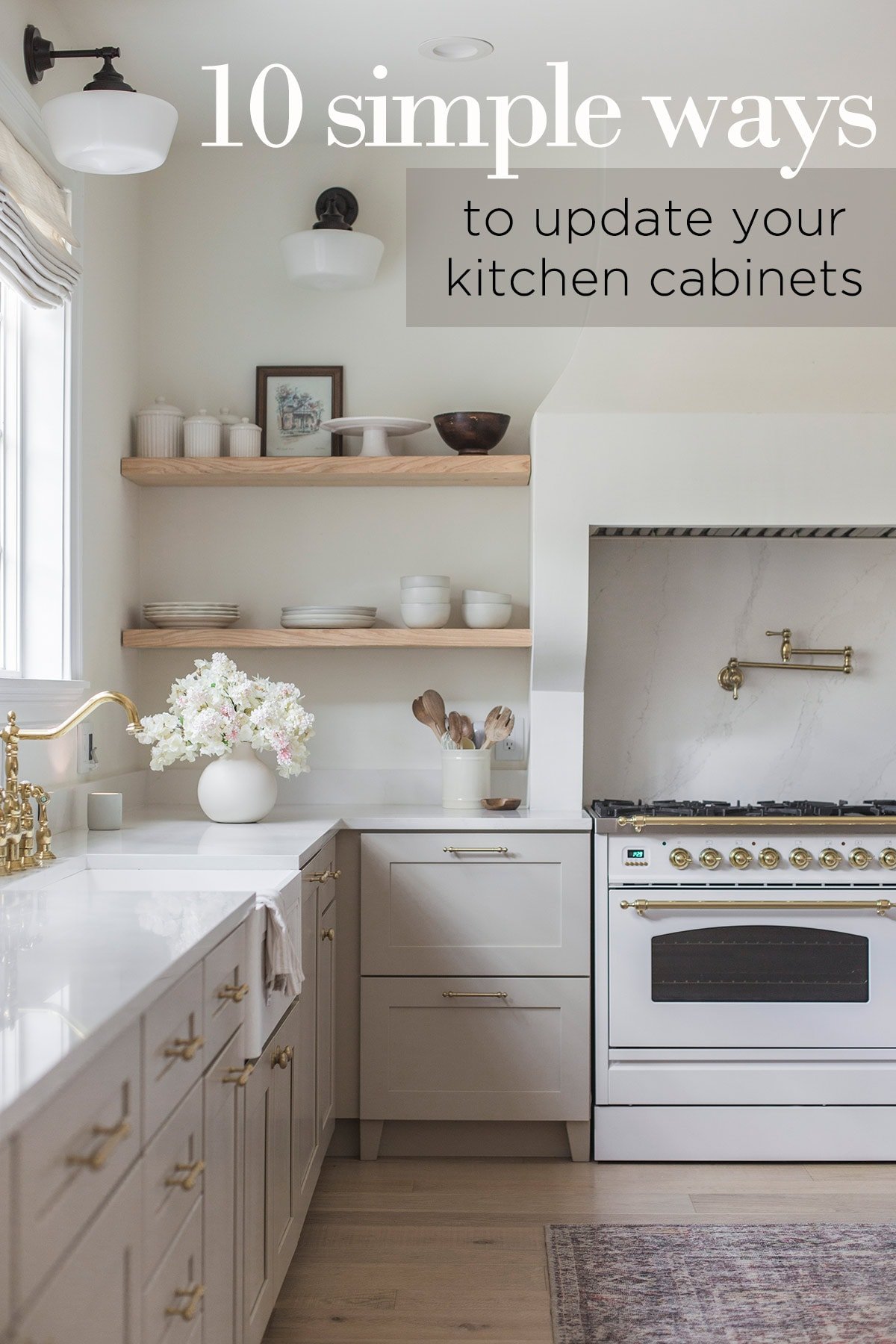To add trim to kitchen cabinets, measure and cut the trim pieces to fit each cabinet door or drawer face, then attach them using wood glue and finish nails. This will enhance the overall appearance of the cabinets and give them a more finished and customized look.
Adding trim is a simple and cost-effective way to upgrade the style of your kitchen without having to replace the entire cabinet set. By following a few easy steps, you can transform your plain cabinets into a beautiful focal point in your kitchen.
We will guide you through the process of adding trim to your kitchen cabinets, providing you with all the necessary information and tips to achieve a professional-looking result.

Credit: www.jennasuedesign.com
Selecting The Right Trim
Selecting the Right Trim for your kitchen cabinets is crucial in achieving the desired aesthetic look. Consider Your Kitchen Style and Evaluate Different Trim Options to enhance the overall appeal of your kitchen.
Consider Your Kitchen Style
Start by assessing the design and theme of your kitchen. Choose a trim that complements the existing style to create a cohesive look. Traditional, modern, or farmhouse – ensure the trim aligns with your chosen kitchen design.
Evaluate Different Trim Options
There are various trim options available for kitchen cabinets. From simple straight moldings to intricate decorative trims, explore different styles to find the one that best suits your kitchen. Consider factors like material, color, and size when selecting the trim.

Credit: www.amazon.com
Gathering Materials And Tools
Before adding trim to kitchen cabinets, gathering the necessary materials and tools is essential. Look for items such as trim pieces, a miter saw, wood glue, and a nail gun to pre-cut and attach the trim. This step ensures a smooth process when updating your kitchen cabinets with a fresh, new look.
Before you start adding trim to your kitchen cabinets, it’s important to gather all the necessary materials and tools. This will ensure a smooth and efficient process, allowing you to achieve professional-looking results. In this section, we will walk you through the list of materials you’ll need as well as the essential tools required for the project. Let’s dive in!
List Of Materials Needed
To get started with adding trim to your kitchen cabinets, make sure you have the following materials:
- Trim boards: Choose trim boards that best match the style and finish of your existing cabinets.
- Construction adhesive: Use a high-quality construction adhesive to secure the trim boards in place.
- Nails: To reinforce the adhesion of the trim boards, you’ll need nails that are appropriate for woodworking.
- Sandpaper: Sandpaper will be necessary to smooth out any rough edges or imperfections on the trim boards.
- Primer: Applying a coat of primer will promote better adhesion of paint or stain to the trim.
- Paint or stain: Depending on your preference, you’ll need paint or stain to add the finishing touch to the trim.
- Paintbrushes: Different sizes of paintbrushes will help you achieve precision when painting or staining the trim.
- Tape measure: Accurate measurements are key to ensuring the trim fits perfectly on your cabinets, so don’t forget a tape measure.
Tools Required For The Project
In addition to the materials, you’ll need the following tools to successfully add trim to your kitchen cabinets:
- Miter saw: A miter saw will allow you to make precise angled cuts on the trim boards for perfect corners.
- Brad nailer: This handy tool will help you securely attach the trim boards to the cabinets with minimal effort.
- Hammer: A hammer can be used in conjunction with the brad nailer to ensure the trim boards are securely fastened.
- Sa
Measuring And Cutting Trim
When it comes to giving your kitchen a fresh new look, adding trim to your cabinets can make a significant impact. Measuring and cutting trim is a crucial step in this process that requires precision and attention to detail. Let’s dive into the key points of taking accurate measurements and cutting the trim to size for your kitchen cabinets.
Taking Accurate Measurements
Before you start cutting the trim, it’s essential to take precise measurements of your kitchen cabinets. Here’s how you can do it:
- Use a tape measure to determine the length of each section where the trim will be installed.
- Measure the width and depth of the cabinet frames to ensure the trim will fit perfectly.
- Take measurements on both sides of the cabinet doors for symmetry and balance.
Cutting The Trim To Size
Once you have the accurate measurements, the next step is cutting the trim to the right size. Follow these tips for precise cuts:
- Use a Miter Saw: A miter saw is the best tool for cutting trim at precise angles for the corners of the cabinets.
- Secure the Trim: Use clamps to hold the trim securely in place and prevent any movement during the cutting process.
- Double-Check Measurements: Before making any cuts, double-check your measurements to avoid any mistakes or misalignments.
- Smooth Edges: After cutting, sand the edges of the trim to ensure a seamless and professional finish.
Preparing The Cabinet Surface
Preparing the cabinet surface is an essential step in adding trim to kitchen cabinets. It ensures that the trim adheres properly, providing a seamless and professional finish. The process involves cleaning the cabinets, sanding, and priming to create an ideal surface for the trim to be applied.
Cleaning The Cabinets
Before adding trim, clean the cabinets thoroughly to remove any dirt, grease, or residue. Use a mild detergent mixed with water to wipe down the surfaces. Be sure to rinse the cabinets with clean water and allow them to dry completely before proceeding.
Sanding And Priming For Adhesion
Sanding the cabinet surfaces is crucial to ensure proper adhesion of the trim. Use fine-grit sandpaper to lightly roughen the surface, creating a better bonding surface for the adhesive. After sanding, apply a primer specifically designed for adhesion. This will further enhance the bond between the cabinet surface and the trim.
Applying The Trim
Add an elegant touch to your kitchen cabinets by applying trim. This step-by-step guide will show you how to effortlessly enhance the overall look and feel of your kitchen with trim.
Using The Right Adhesive
Adding trim to kitchen cabinets requires the proper adhesive to ensure a secure and long-lasting application. The type of adhesive you choose should be suitable for both the trim material and the cabinet surface. A strong adhesive will prevent the trim from peeling or coming loose over time. When selecting your adhesive, check the product label for compatibility with both surfaces and ensure it is designed for woodworking projects or specifically for cabinet trim applications. For a seamless and professional finish, opt for a clear adhesive that dries transparently.
Ensuring Proper Alignment And Placement
The key to achieving a polished look when adding trim to kitchen cabinets lies in ensuring proper alignment and placement. Here are some guidelines to follow for a flawless finish:
1. Measure twice, cut once: Before starting the installation, measure carefully and make precise cuts for the trim pieces. This step is essential in achieving accurate alignment and reducing the need for excessive adjustments later on.
2. Mark the placement: Use a pencil or masking tape to mark the desired placement of the trim on the cabinet. These markings will act as a guide when attaching the trim and will help maintain consistency throughout the installation process.
3. Dry fit the trim: Before applying adhesive, test the fit of the trim pieces by placing them on the cabinet. This step allows you to make any necessary adjustments or fine-tune the alignment before permanently fixing the trim.
4. Apply adhesive strategically: Apply a thin and even layer of adhesive to both the backside of the trim and the designated area on the cabinet. Avoid using excessive amounts of adhesive, as this can result in a messy, uneven application.
5. Press firmly and secure in place: Once the adhesive is applied, firmly press the trim into place, ensuring it aligns with the previously marked indicators. Use clamps or a weighted object to hold the trim in place while the adhesive dries.
6. Clean up any excess adhesive: If any adhesive seeps out during the application process, quickly wipe it away with a damp cloth before it dries. This step will help maintain a clean and professional appearance.
By following these steps and using the right adhesive, you can successfully add trim to your kitchen cabinets, transforming their look and adding a touch of elegance to your space. Remember to take your time during the installation process, double-check measurements, and ensure proper alignment for a flawless end result.
Finishing Touches
Add trim to your kitchen cabinets to elevate their look with simple yet effective finishing touches.
Filling Gaps And Caulking
- Fill any gaps between the cabinet and trim with wood filler.
- Ensure a seamless finish by smoothing the filler with a putty knife.
- Caulk all edges to create a clean and polished appearance.
Painting Or Staining The Trim
- Prepare the trim by sanding it lightly to promote adhesion.
- Apply a primer coat to enhance durability and coverage.
- Choose a paint or stain that complements your kitchen cabinets.
- Brush or roll on the finish, ensuring even distribution.
Maintenance And Care Tips
Adding trim to kitchen cabinets can enhance the overall look and feel of your space, but proper maintenance is essential to preserve its appearance and functionality. Here are some H3> Maintenance and Care Tips:
Cleaning And Maintaining Trim
- Regularly dust and wipe down the trim using a soft cloth to prevent dust buildup.
- Use a mild soap and water solution to clean the trim, avoiding harsh chemicals that may damage the finish.
- Dry the trim thoroughly to prevent water stains or warping.
Addressing Wear And Tear
- Inspect the trim regularly for any signs of wear, such as peeling paint or cracks.
- Touch up any areas of damage with matching paint or finish to maintain a seamless look.
- Consider replacing trim that is extensively damaged to preserve the aesthetics of your cabinets.

Credit: www.younghouselove.com
Frequently Asked Questions On How To Add Trim To Kitchen Cabinets
How Can I Add Trim To Kitchen Cabinets?
To add trim to kitchen cabinets, start by measuring and cutting the trim to fit the cabinets. Then, glue and nail the trim in place, ensuring it is properly aligned. Fill any gaps with wood filler, sand it smooth, and finish with paint or stain for a polished look.
What Tools Do I Need For Adding Trim To Cabinets?
For adding trim to cabinets, you will need essential tools such as a measuring tape, miter saw, wood glue, brad nailer, wood filler, sandpaper, and paint or stain. These tools will help you accurately measure, cut, attach, and finish the trim for a professional-looking result.
Can I Add Trim To Cabinets Without Professional Help?
Yes, you can definitely add trim to cabinets without professional help. With the right tools, measurements, and step-by-step guidance, adding trim to cabinets can be a manageable DIY project. Just make sure to follow the proper techniques and take your time to achieve the desired results.
Conclusion
Adding trim to kitchen cabinets is a simple and effective way to enhance the overall look and feel of your space. By following the step-by-step guide provided in this blog post, you can easily achieve a professional-looking result. Whether you choose to add trim for aesthetic purposes or to cover up imperfections, this DIY project is accessible to all skill levels.
So why wait? Start transforming your kitchen cabinets today and enjoy the renewed beauty of your space.

Sohel Rana is a seasoned author whose passion for home and kitchen essentials permeates through his writing. Born and raised in a small town nestled amidst lush greenery, Rana’s fascination with the intricacies of domestic life blossomed from an early age. His upbringing in a close-knit family environment instilled in him a deep appreciation for the importance of a well-equipped kitchen and a cozy home

